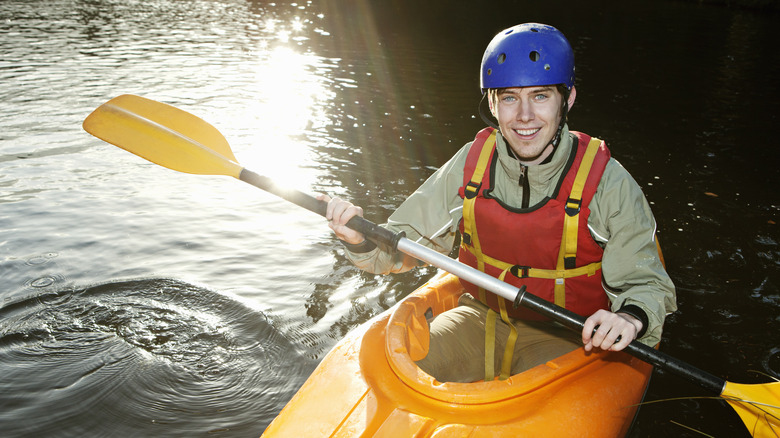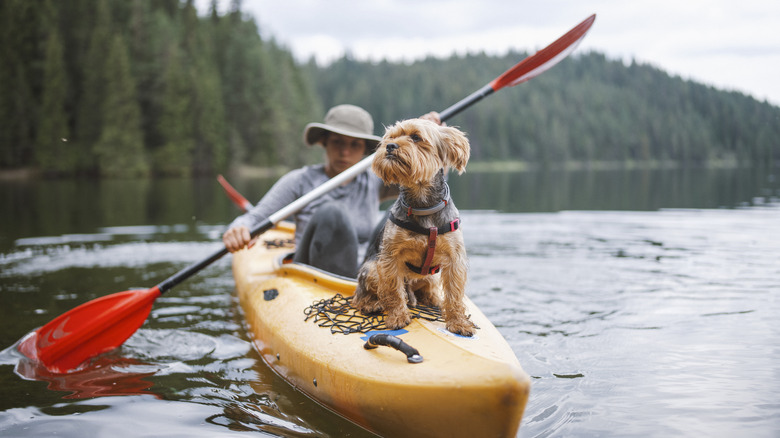Simple Rules To Keep In Mind During Your Next Kayaking Or Canoeing Adventure
It's the best time of the year — time to get back out on the water. Whether you're heading out onto the lake or psyching up to huck yourself over the falls, these simple rules will help you make it to the pull-out point with your phone dry.
Canoeing and kayaking is an interesting category of sport. At one end of the scale, it can be a super gentle activity enjoyed by people of all ages, rowing over smooth waters and packing along a picnic lunch. On the other end, like when Dane Jackson drops into a 134-foot waterfall, extreme whitewater kayaking is one of the gnarliest things humans have ever done. No matter where you fall on the scale, these simple tips, sometimes referred to as the three golden rules of kayaking, are here to help:
- Let your upper and lower bodies work independently but together — like you're a seasoned drummer.
- Your true power comes from torso rotation. Paddling with your arms only is a classic kayaking mistake.
- Keep your hands in your field of vision.
Read on to learn more about these techniques, take some time to practice them in the lake, and you'll learn to kayak in control, keep your strength, and paddle faster when you hear banjos.
The three golden rules of kayaking explained
Hopefully, if you're reading this, you're not about to follow Dane Jackson down a river. First, let's work on upper and lower-hemisphere independence. Think of your body as separate at your hips; use your upper body to generate paddle power and engage your lower body to keep an even keel or tilt your craft while performing carving turns. Your upper body is responsible for generating paddle power, while your lower body provides you with stability. Try to avoid simply engaging your left leg muscles just because you are paddling on the left side of your boat. Focusing on our second rule will help maintain that separation.
Proper torso rotation in a kayak means you paddle with your entire upper body instead of just using your arms. To engage your torso properly, twist at your waist and reach the paddle with your shoulder instead of extending your elbow and yanking your arm to the paddle. A good way to tell that your torso is engaged is if you are also following rule number three: keeping your hands in front. This is your power position, and it's engaged when your chest, arms, and paddle form a box shape. Even when paddling backward or taking an awkward angle, you never want to stick your hands behind your body to paddle, as it creates weak strokes and can lead to shoulder injuries.
More things to keep in mind on the water
These simple rules are here to help you get comfortable in rougher conditions, but no theory can replace practice when it comes to improving your kayaking. Keep these golden rules to heart, and also consider the following safety points. We've got to be respectful of our limits on the water. Don't push yourself out of your comfort zone. When we see pros bombing serious rapids, it can look easy, but nobody gets through Category 5 falls without spending some serious time practicing rolling in still water.
Check out how easy it will be to get to shore, any currents, wind, or rapids, and the total distance you'll have to cover. Make sure you're ready for the task at hand before you head out into fast-moving rapids, unprotected waterways, or further from shore than you can comfortably swim. No matter how comfortable you are, kayaking has hidden dangers that can flip a boat in seconds. Have a plan in place in the event you capsize. You might need to practice your ability to roll yourself back upright if you flip. It's a whole lot easier to flip upright on a lake than it is when you're rushing toward a rock. Re-entering is a simpler task on a sit-on-top craft or canoe, but still, mentally prepare yourself for a rough swim to shore and put your phone in a dry bag.


